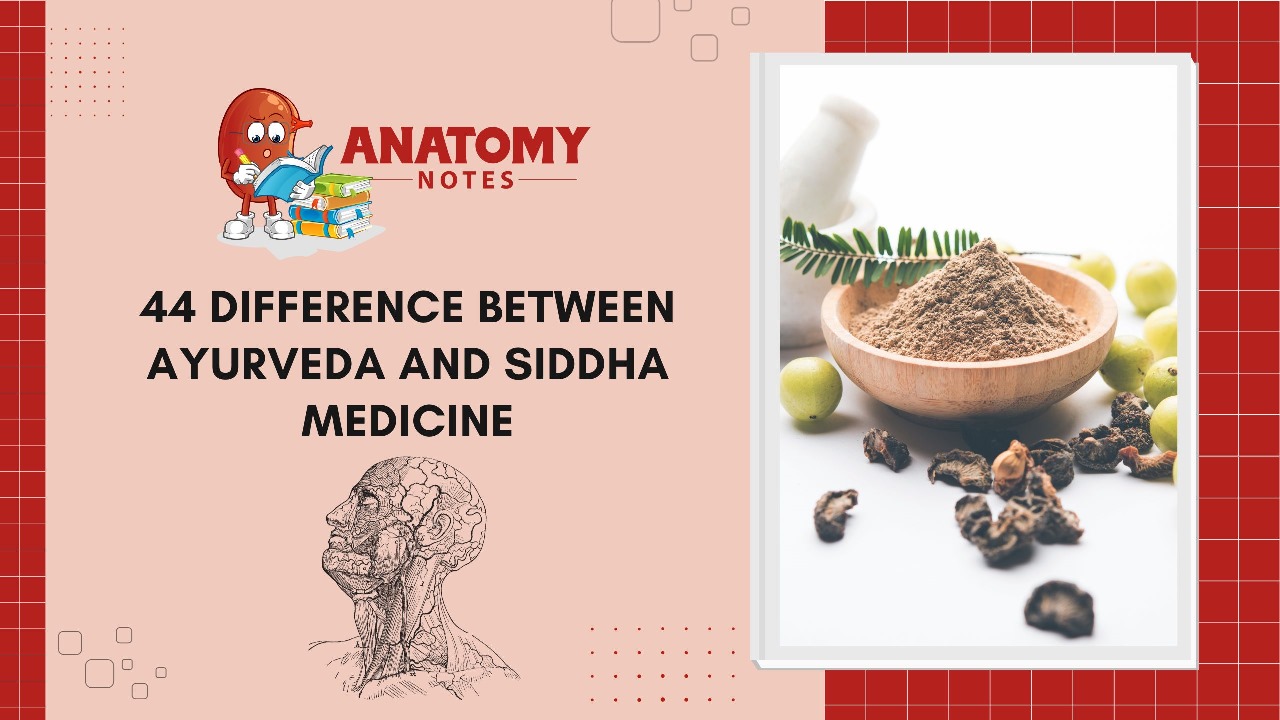The Indian traditional healing systems Ayurveda and Siddha Medicine continue to influence healthcare. They differ in philosophy, ideals, and practises despite certain commonalities.
As “knowledge of life,” Ayurveda is a comprehensive medicine that has been practised for over 5,000 years. The body and mind are interrelated, and health is accomplished by balancing the three doshas—Vata (air and space), Pitta (fire and water), and Kapha (earth and water). Herbal medicines, food changes, yoga, and meditation may restore equilibrium in Ayurveda. Ayurveda customises remedies to each patient’s Prakriti.
Siddha Medicine, rooted in ancient Tamil culture, emphasises “Pancha Bhoota,” the five elements: earth, water, fire, air, and space. Natural ingredients, minerals, and herbs are used by Siddha practitioners to restore balance and heal ailments. Mantra chanting and meditation are part of Siddha Medicine. Siddha Medicine focuses on the ailment rather than your constitution, unlike Ayurveda.
Different histories are another factor. Ayurveda has affected many traditional medicinal systems worldwide, whereas Siddha Medicine thrives in southern India, notably Tamil Nadu. In order to determine dosha imbalance, Ayurveda uses pulse diagnosis (Nadi Pariksha), tongue examination, and patient history, whereas Siddha Medicine uses pulse diagnosis, physical tests, and astrological considerations. Both Ayurveda and Siddha Medicine contain a vast herbal pharmacopoeia, however the plants and preparations vary.
Ayurveda and Siddha Medicine are two ancient Indian healing systems. Siddha Medicine balances the five elements and adds spirituality, whereas Ayurveda emphasises dosha balance and individualised care. Understand the distinctions between these systems to pick the ideal one for your health and fitness needs.
|
S.No. |
Aspect |
Ayurveda |
Siddha Medicine |
|
1 |
Origin |
Originated in ancient India |
Originated in ancient South India |
|
2 |
Historical Texts |
Main texts include Charaka Samhita, Sushruta Samhita |
Main texts include Siddha Vaidya Thirattu, Siddha Vaidya Keelakam |
|
3 |
Philosophy |
Focuses on balance of doshas (Vata, Pitta, Kapha) |
Emphasizes the balance of 72 fundamental elements (Marutham, Neithal, etc.) |
|
4 |
Fundamental Elements |
Based on 5 elements (earth, water, fire, air, ether) |
Based on 96 basic elements (oru, rendu, moonu, etc.) |
|
5 |
Diagnosis |
Uses pulse diagnosis (Nadi Pariksha) |
Uses pulse diagnosis (Nadi Pariksha) |
|
6 |
Treatment Approach |
Holistic approach to health and well-being |
Holistic approach to health and well-being |
|
7 |
Herbal Medicines |
Relies heavily on herbal medicines |
Utilizes herbs and minerals extensively |
|
8 |
Metal and Mineral Use |
Limited use of metals and minerals |
Extensive use of metals and minerals |
|
9 |
Therapies |
Incorporates Panchakarma therapies |
Utilizes various therapies like Varmam, Thokkanam, etc. |
|
10 |
Dietary Guidelines |
Emphasizes dietary guidelines based on dosha types |
Recommends specific diets based on individual prakriti (constitution) |
|
11 |
Medicinal Formulations |
Uses decoctions, powders, oils, and pills |
Uses various preparations including parpam, chendooram, lehiyam, etc. |
|
12 |
Focus on Prakriti |
Considers individual constitution (Prakriti) |
Considers individual constitution (Prakriti) |
|
13 |
Pulse Diagnosis |
Important in diagnosis and treatment |
Important in diagnosis and treatment |
|
14 |
Astrology Influence |
May consider astrological factors |
Less emphasis on astrology in treatment |
|
15 |
Herbal Combination |
Often combines herbs based on dosha imbalances |
Combines herbs based on elemental principles |
|
16 |
Siddha Metals |
Limited use of metals like gold and silver |
Uses mercury, arsenic, and other metals extensively |
|
17 |
Siddha Materia Medica |
Contains unique Siddha medicinal substances |
Includes rare and unique Siddha medicinal substances |
|
18 |
Traditional Healers |
Practiced by Vaidyas and Ayurvedic physicians |
Practiced by Siddhars and traditional Siddha healers |
|
19 |
Body Constitution Types |
Three dosha-based body types (Vata, Pitta, Kapha) |
Eight body types based on elements (Ainthinai) |
|
20 |
Disease Classification |
Classifies diseases into Tridosha categories |
Classifies diseases based on elemental imbalances |
|
21 |
Mantras and Prayers |
May use mantras and prayers in healing |
Incorporates mantras and prayers in healing |
|
22 |
Yoga Integration |
Integrates yoga for health and balance |
Emphasizes yoga for overall well-being |
|
23 |
Medicinal Oils |
Uses herbal oils for massage and treatments |
Utilizes specific Siddha medicinal oils |
|
24 |
Marma Points |
Acknowledges Marma points for therapy |
Utilizes Marma points in therapeutic techniques |
|
25 |
Pulse Variation |
Focuses on variations in pulse diagnosis |
Emphasizes unique pulse characteristics |
|
26 |
Panchamahabhuta Theory |
Utilizes five elements theory (Panchamahabhuta) |
Extends elemental theory with 96 elements |
|
27 |
Prana and Ojas |
Considers Prana (life force) and Ojas (vital essence) |
Considers vital energy and Oorja (vitality) |
|
28 |
Detoxification Methods |
Utilizes Panchakarma for detoxification |
Has its detoxification methods |
|
29 |
Scientific Validation |
Gaining recognition in modern medicine |
Less recognized in modern medical science |
|
30 |
Language of Texts |
Primarily in Sanskrit and regional languages |
Primarily in Tamil and Siddha-specific terminology |
|
31 |
Treatment Duration |
Treatment durations vary widely |
Treatment durations often lengthy |
|
32 |
Ayurvedic Massage |
Utilizes Abhyanga massage |
Has its unique massage techniques |
|
33 |
Siddha Meditation |
May incorporate specific Siddha meditation practices |
May include meditation for holistic healing |
|
34 |
Geriatric Medicine |
Addresses geriatric care |
Offers specialized care for the elderly |
|
35 |
Legal Recognition |
Recognized by the Government of India |
Gaining recognition in some regions |
|
36 |
Geographic Focus |
Practiced worldwide |
Mainly practiced in South India |
|
37 |
Modern Integration |
Integrated into some modern healthcare systems |
Limited integration into modern healthcare |
|
38 |
Practitioner Training |
Requires formal Ayurvedic education |
Requires specialized Siddha training |
|
39 |
Global Awareness |
Gaining popularity globally |
Less well-known outside South Asia |
|
40 |
Clinical Research |
Growing body of clinical research |
Limited clinical research available |
|
41 |
Patents and Formulations |
Some Ayurvedic formulations patented |
Some Siddha formulations patented |
|
42 |
Healthcare Settings |
Offered in Ayurvedic hospitals and clinics |
Provided in traditional Siddha clinics |
|
43 |
Focus on Pulse Therapy |
Emphasizes pulse therapy (Nadi Pariksha) |
Focuses on pulse therapy for diagnosis |
|
44 |
Holistic Health System |
Part of India’s traditional holistic healthcare system |
Integral part of Tamil culture and healthcare system |
Frequently Asked Questions (FAQs)
Q1: What distinguishes Ayurveda from Siddha Medicine?
Philosophical principles and treatment methods distinguish Ayurveda and Siddha Medicine. Ayurveda balances doshas (Vata, Pitta, and Kapha) to sustain health, while Siddha Medicine balances Pancha Bhoota (earth, water, fire, air, and space). In addition, Ayurveda emphasises individual constitution (Prakriti), whereas Siddha Medicine concentrates on treating particular illnesses.
Q2: How do Ayurveda and Siddha diagnose illness?
For dosha imbalance diagnosis in Ayurveda, Nadi Pariksha (pulse diagnosis), tongue examination, and a complete medical history are used. However, Siddha Medicine diagnoses ailments using pulse diagnostics, physical exams, and astrology. Both techniques diagnose pulses, but their approaches differ.
Q3: Are Ayurvedic and Siddha herbal medicines the same?
Ayurveda and Siddha Medicine use herbs, however their formulas and ingredients vary. Siddha Medicine uses herbs and minerals, whereas Ayurveda uses a wide range of herbs and formulas. Each system’s concepts and philosophies and the patient’s condition determine the treatment.
Q4: Where are these traditional healing techniques popular?
Indian and international Ayurveda is widely practised. It inspired many traditional therapeutic techniques. Siddha Medicine is mostly practised in Tamil Nadu and the south. Siddha Medicine is more localised, but Ayurveda is universal.
Q5: Do these systems use spirituality in healing?
While Ayurveda and Siddha Medicine include spiritual components in their therapy, the amount and type varies. Yoga and meditation improve mental and physical harmony in Ayurveda. Siddha Medicine treats health conditions using herbs, meditation, mantra chanting, and spiritual ceremonies. Both systems use spiritual elements to create holistic wellbeing.




